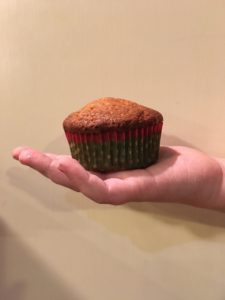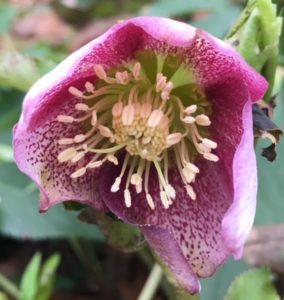 Like leftover ornaments on an abandoned Christmas tree, a few hardy blossoms offer bright spots of color in my winter landscape. How (and why!) these blossoms come in mid-winter is a mystery, but I am so glad they do! I know they are not really harbingers of spring. They are more like “tide-me-overs”, offering a little bit of flower beauty to keep gardeners going until spring weather brings a tidal wave of petals, color and fragrance.
Like leftover ornaments on an abandoned Christmas tree, a few hardy blossoms offer bright spots of color in my winter landscape. How (and why!) these blossoms come in mid-winter is a mystery, but I am so glad they do! I know they are not really harbingers of spring. They are more like “tide-me-overs”, offering a little bit of flower beauty to keep gardeners going until spring weather brings a tidal wave of petals, color and fragrance. 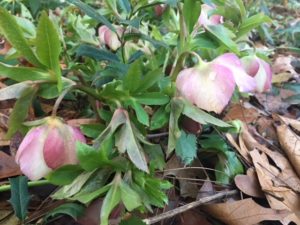
By far the most prolific of my “winter wonders” are the pink and white blooms of lenten rose (Hellebores.) With their freckled faces, they are truly lovely flowers, though you practically have to get down on your knees to see them. Lenten roses “nod,” hanging from the stem with their faces turned toward the ground. Perhaps this offers extra protection from the cold winds? or maybe they are just shy.
These flowers would be welcomed any time of year, but the fact that they come in the middle of winter makes they even more precious. Lenten roses are easy to grow and will spread rapidly when growing in a happy home.
Although there are many cultivars available now, offering double flowers and brighter colors, I like my hellebores just the way they are. I transplanted these from my Mama’s garden and what was good enough for Mama is good enough for me.
 A little easier to spot are the blossoms from the ubiquitous and invasive Mahonia. Native to China, this hardy shrub has found perfect growing conditions in southern woods and is now considered a damaging invasive species. Although the lemon yellow flowers are pretty, clip them off once they have bloomed to prevent Mahonia from spreading further.
A little easier to spot are the blossoms from the ubiquitous and invasive Mahonia. Native to China, this hardy shrub has found perfect growing conditions in southern woods and is now considered a damaging invasive species. Although the lemon yellow flowers are pretty, clip them off once they have bloomed to prevent Mahonia from spreading further.
 Two years ago, my sister, Sharon, gave me a small paper bush (Edgeworthia). The first year I was afraid it wouldn’t survive. The next year, I was afraid it was going to take over the garden. It is a hardy shrub that produces very fragrant, white or yellow flowers in mid to late winter. Though it gets big (up to 8 feet tall and 15 feet wide), it is not invasive.
Two years ago, my sister, Sharon, gave me a small paper bush (Edgeworthia). The first year I was afraid it wouldn’t survive. The next year, I was afraid it was going to take over the garden. It is a hardy shrub that produces very fragrant, white or yellow flowers in mid to late winter. Though it gets big (up to 8 feet tall and 15 feet wide), it is not invasive.
I love all these winter flowers and are grateful for them, but I have to admit, I’m ready for a change of seasons. Last Friday, I threw a party for all the groundhogs in my back yard, set up a tent and offered umbrellas so no one would be scared of a shadow and jump back in the ground again to prolong winter. As for me and my groundhogs? We’re ready for spring.

 Atlanta has been unusually cold this winter and, of course, there have been the usual jokes about “oh my! Atlanta had 1/2 inch of snow and schools were cancelled!” But, the truth of the matter is, we’re a southern city unsuited and basically unprepared for frigid temperatures and any kind of snowfall. Our inability to deal with “winter” includes not only people who don’t know how to drive on snow, but also people who have no shelter or protection from the elements.
Atlanta has been unusually cold this winter and, of course, there have been the usual jokes about “oh my! Atlanta had 1/2 inch of snow and schools were cancelled!” But, the truth of the matter is, we’re a southern city unsuited and basically unprepared for frigid temperatures and any kind of snowfall. Our inability to deal with “winter” includes not only people who don’t know how to drive on snow, but also people who have no shelter or protection from the elements.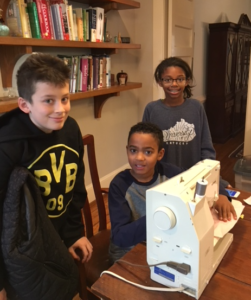

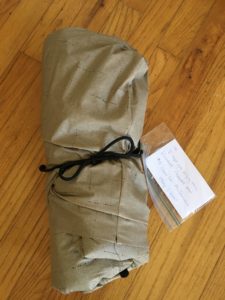
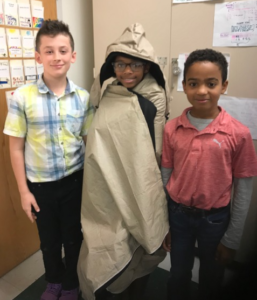

 I love my house and love my garden but I am shout-out-loud-Halleluja and down-on-my-knees grateful for my studio. Nestled above the garage, it looks out over the garden in the back. It is a space close to the house (commute time: 45 seconds) but not IN the house, making it a perfect space to work and create.
I love my house and love my garden but I am shout-out-loud-Halleluja and down-on-my-knees grateful for my studio. Nestled above the garage, it looks out over the garden in the back. It is a space close to the house (commute time: 45 seconds) but not IN the house, making it a perfect space to work and create.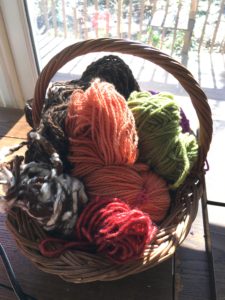
 Whether you draw, paint, stitch, weave, quilt, write or simply think about doing all these things (and more!) a special place set aside for creativity will probably enhance your ability to make these schemes come true.
Whether you draw, paint, stitch, weave, quilt, write or simply think about doing all these things (and more!) a special place set aside for creativity will probably enhance your ability to make these schemes come true.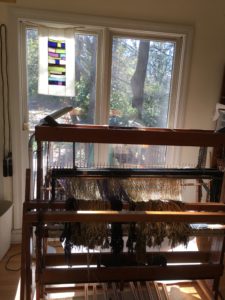
 When he was just a little tyke, my (now 10 year old) grandson, Rivers, called the window greenhouse in my kitchen his “jungle.” Over the years our jungle has grown significantly and is a source of constant pleasure, particularly during the cold months when it’s difficult to garden outside.
When he was just a little tyke, my (now 10 year old) grandson, Rivers, called the window greenhouse in my kitchen his “jungle.” Over the years our jungle has grown significantly and is a source of constant pleasure, particularly during the cold months when it’s difficult to garden outside.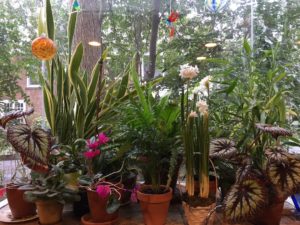
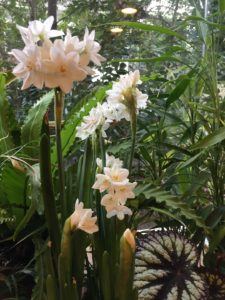
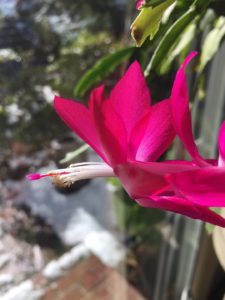
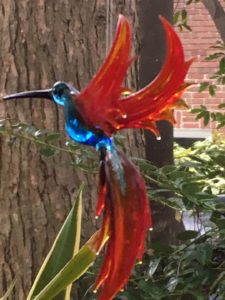 said that they should be in our jungle. So, we hung them from fishing line and they add a touch of the exotic year round to the jungle.
said that they should be in our jungle. So, we hung them from fishing line and they add a touch of the exotic year round to the jungle.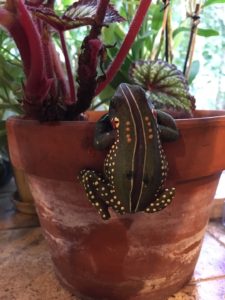
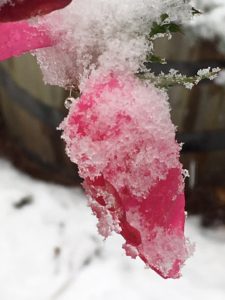 I really don’t mind the cold. Actually, I love it. Except for this morning when I went downstairs and realized that it was freezing cold – inside. The furnace wasn’t coming on. What???!!! I was only kidding about liking the cold. It’s fine for it to be 16 degrees outside as long as I’m toasty warm inside!!!
I really don’t mind the cold. Actually, I love it. Except for this morning when I went downstairs and realized that it was freezing cold – inside. The furnace wasn’t coming on. What???!!! I was only kidding about liking the cold. It’s fine for it to be 16 degrees outside as long as I’m toasty warm inside!!!
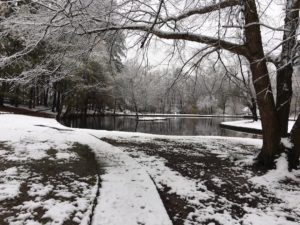 , especially if they occur really early or really late in the season. But January, when the trees are dormant, is a good time to have frigid temperatures.
, especially if they occur really early or really late in the season. But January, when the trees are dormant, is a good time to have frigid temperatures.

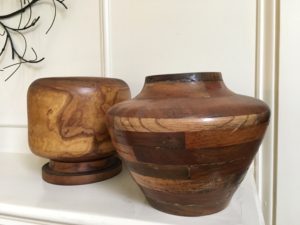

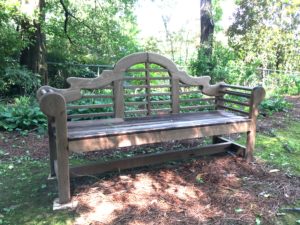
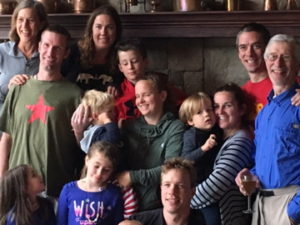
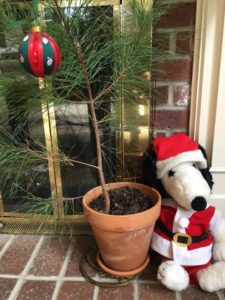 Although we have a magnificent 9 foot Christmas tree in the front hall, it’s our “Charlie Brown” pine tree with a single ornament that makes me smile every time I look at it. Maybe it’s because it was free (I just pulled it up from the woods near the lake) or because it took less than 30 seconds to decorate (as opposed to hours for the lights and more hours for the ornaments on the big tree.)
Although we have a magnificent 9 foot Christmas tree in the front hall, it’s our “Charlie Brown” pine tree with a single ornament that makes me smile every time I look at it. Maybe it’s because it was free (I just pulled it up from the woods near the lake) or because it took less than 30 seconds to decorate (as opposed to hours for the lights and more hours for the ornaments on the big tree.)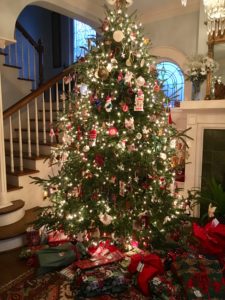
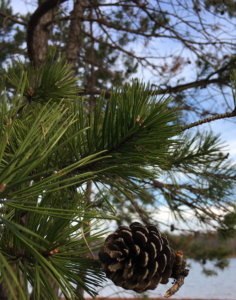
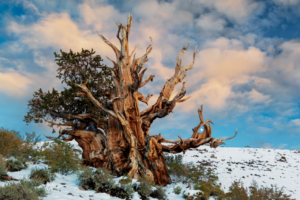
 I got up early one morning last week to work. As I sat at the kitchen counter, I glanced outside and saw a raccoon scampering up a tree just a foot away from the house. By the time I grabbed my phone and opened the door, he had jumped to the roof. Seemingly unafraid, he did not move but just stared at me for long moments. I finally got cold and closed the door.
I got up early one morning last week to work. As I sat at the kitchen counter, I glanced outside and saw a raccoon scampering up a tree just a foot away from the house. By the time I grabbed my phone and opened the door, he had jumped to the roof. Seemingly unafraid, he did not move but just stared at me for long moments. I finally got cold and closed the door.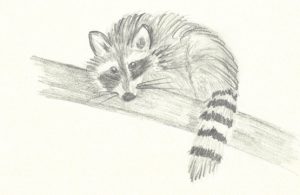 Raccoons are easy to identify because of their masked faces and ringed tails. They weigh 8 – 18 pounds and measure 2 – 3 feet, including the tail. Raccoons have adapted well to living near humans and large populations can be found in cities and towns. They need to live near water and are abundant along wooded streams.
Raccoons are easy to identify because of their masked faces and ringed tails. They weigh 8 – 18 pounds and measure 2 – 3 feet, including the tail. Raccoons have adapted well to living near humans and large populations can be found in cities and towns. They need to live near water and are abundant along wooded streams. The Sioux Indians called the raccoon “one who is sacred” or “one with magic,” probably because of its dark mask. The Dakota Sioux called it wee-kah-teg-alega, “sacred one with the painted face.”
The Sioux Indians called the raccoon “one who is sacred” or “one with magic,” probably because of its dark mask. The Dakota Sioux called it wee-kah-teg-alega, “sacred one with the painted face.”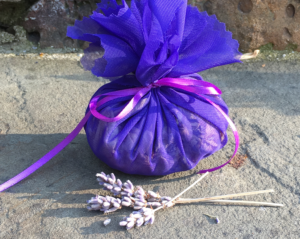 My sweet niece married this fall and I was fortunate enough to be able to do some of the flowers for her beautiful wedding. Per her request, I made arrangements that showcased blues and purples. The main component of the arrangements were perfectly exquisite white roses. After the ceremony, I pulled all the rose petals off, stuffed them in a bag and brought them home.
My sweet niece married this fall and I was fortunate enough to be able to do some of the flowers for her beautiful wedding. Per her request, I made arrangements that showcased blues and purples. The main component of the arrangements were perfectly exquisite white roses. After the ceremony, I pulled all the rose petals off, stuffed them in a bag and brought them home.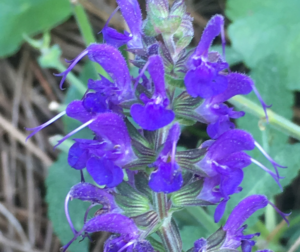
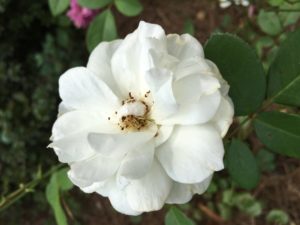
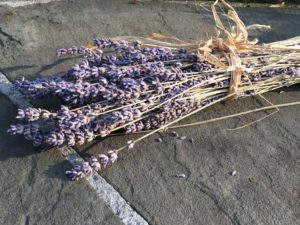

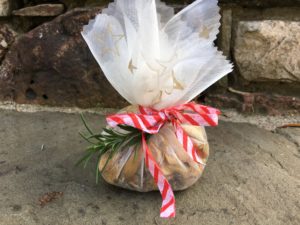
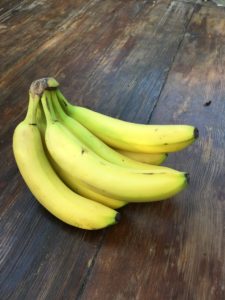 It’s fairly common knowledge that bananas are in trouble. It is conceivable that there will be no bananas in our future due to the devastating effects of a nasty fungus called “fusarium.” Thousands of acres of banana plants in Australia and Southeast Asia have been wiped out and the fungus has now moved to Africa and the Middle East. Latin America (which grows the vast majority of bananas eaten in the U.S.) is dreading its seemingly inevitable arrival.
It’s fairly common knowledge that bananas are in trouble. It is conceivable that there will be no bananas in our future due to the devastating effects of a nasty fungus called “fusarium.” Thousands of acres of banana plants in Australia and Southeast Asia have been wiped out and the fungus has now moved to Africa and the Middle East. Latin America (which grows the vast majority of bananas eaten in the U.S.) is dreading its seemingly inevitable arrival.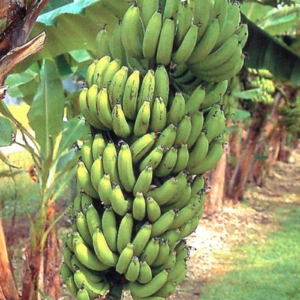
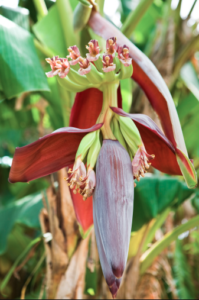 Researchers are working feverishly to develop disease resistant plants before it’s too late. They are making progress by genetically altering ‘Cavendish’ to include genes that are resistant to this particular fungus.
Researchers are working feverishly to develop disease resistant plants before it’s too late. They are making progress by genetically altering ‘Cavendish’ to include genes that are resistant to this particular fungus.